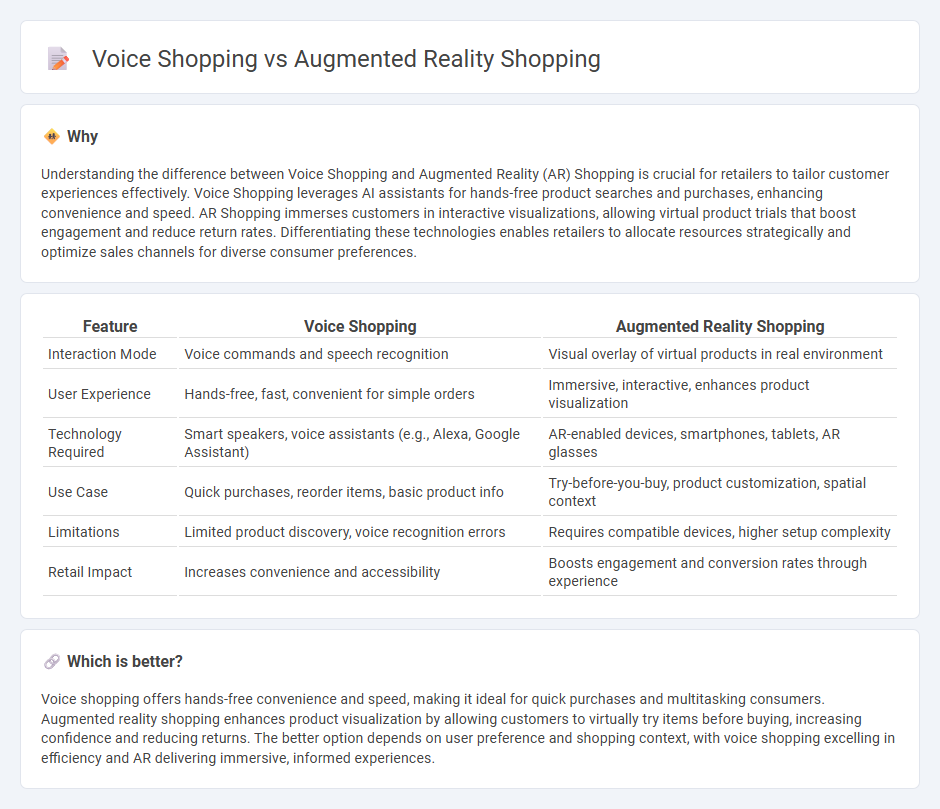
Voice shopping leverages AI-powered virtual assistants to enable seamless, hands-free purchasing through simple voice commands, enhancing convenience and accessibility in retail. Augmented reality shopping transforms the consumer experience by overlaying digital information and visualizations onto the physical environment, allowing for interactive product trials and personalized customization. Discover how these innovative technologies are reshaping retail dynamics and customer engagement.
Why it is important
Understanding the difference between Voice Shopping and Augmented Reality (AR) Shopping is crucial for retailers to tailor customer experiences effectively. Voice Shopping leverages AI assistants for hands-free product searches and purchases, enhancing convenience and speed. AR Shopping immerses customers in interactive visualizations, allowing virtual product trials that boost engagement and reduce return rates. Differentiating these technologies enables retailers to allocate resources strategically and optimize sales channels for diverse consumer preferences.
Comparison Table
| Feature | Voice Shopping | Augmented Reality Shopping |
|---|---|---|
| Interaction Mode | Voice commands and speech recognition | Visual overlay of virtual products in real environment |
| User Experience | Hands-free, fast, convenient for simple orders | Immersive, interactive, enhances product visualization |
| Technology Required | Smart speakers, voice assistants (e.g., Alexa, Google Assistant) | AR-enabled devices, smartphones, tablets, AR glasses |
| Use Case | Quick purchases, reorder items, basic product info | Try-before-you-buy, product customization, spatial context |
| Limitations | Limited product discovery, voice recognition errors | Requires compatible devices, higher setup complexity |
| Retail Impact | Increases convenience and accessibility | Boosts engagement and conversion rates through experience |
Which is better?
Voice shopping offers hands-free convenience and speed, making it ideal for quick purchases and multitasking consumers. Augmented reality shopping enhances product visualization by allowing customers to virtually try items before buying, increasing confidence and reducing returns. The better option depends on user preference and shopping context, with voice shopping excelling in efficiency and AR delivering immersive, informed experiences.
Connection
Voice shopping and augmented reality (AR) shopping intersect by enhancing customer engagement and streamlining the purchasing process in retail. Voice assistants provide hands-free, personalized product recommendations, while AR enables immersive visualization of products in real-world settings. Together, they create an integrated omnichannel experience that increases conversion rates and customer satisfaction.
Key Terms
Immersive Visualization
Augmented reality shopping offers immersive visualization by allowing customers to virtually interact with products in a 3D environment, enhancing decision-making through detailed spatial understanding and real-time customization. Voice shopping, while convenient, primarily relies on auditory cues and lacks the visual depth that aids in evaluating product features and fit. Explore how immersive visualization is transforming consumer experiences and driving innovation in retail technology.
Voice Command Integration
Voice shopping leverages advanced voice command integration to enable hands-free, seamless purchasing experiences using smart speakers and virtual assistants like Alexa and Google Assistant. Augmented reality shopping, while immersive with visual overlays, relies heavily on device cameras and user interactions rather than voice commands for product visualization and selection. Explore the evolving capabilities of voice command technology and its impact on enhancing convenient, efficient shopping.
Personalization
Augmented reality shopping offers immersive product visualization tailored to individual preferences through real-time interaction and spatial context recognition, enhancing user engagement by allowing customers to virtually try products before purchase. Voice shopping leverages natural language processing and AI-driven recommendation systems to provide personalized suggestions based on purchase history, preferences, and contextual cues, streamlining the shopping experience through hands-free convenience. Explore how these technologies revolutionize personalization in retail by optimizing customer satisfaction and boosting conversion rates.
Source and External Links
AR Shopping: Top Trends and Apps for the Future (2024) - Augmented reality (AR) shopping lets customers virtually try and test products via smartphones or VR headsets, enabling immersive pre-buying experiences like virtual try-ons or placing furniture in homes to better inform purchase decisions.
Top 5 Augmented Reality Apps that Created Immersive ... - AR apps enhance shopping by allowing users to visualize products in their real-world environment, providing a highly immersive try-before-you-buy experience that increases confidence and satisfaction while reducing returns.
AR in Retail: Cool Use Cases & Key Benefits - Leading retailers like IKEA, Sephora, and ASOS use AR technology to let customers see how furniture fits in their space or try on makeup and clothes virtually, significantly boosting engagement and sales by delivering personalized, interactive shopping experiences.
 dowidth.com
dowidth.com